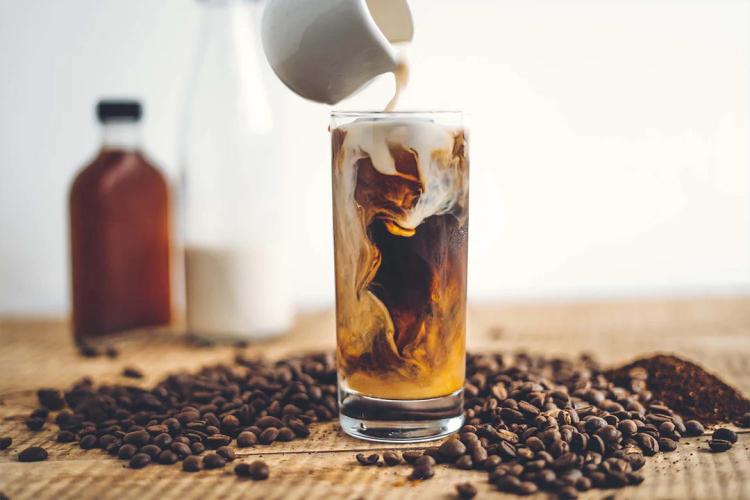
Does Cold Brew Have More Caffeine Than Hot Coffee?
Coffee is a wonderful tool to help get your day started. It’s also delicious and full of health benefits!
Regular hot coffee, iced coffee, cold brew, and espresso-based beverages are just a few options available in the coffee world that could be your go-to morning cup of joe. However, in recent years, cold coffee drinks like cold brew have become more popular. The rise in cold brew’s popularity has led to many questions about its benefits.
Does cold brew have more caffeine than other coffees? Does it just wake you up more because it’s iced? We are here to answer these probing questions about what is in your cup of coffee!
How Is Cold Brew Different Than Regular Coffee?
Cold brew is a smooth, cool, well-crafted coffee beverage that continues to rise in popularity.
Hot coffee, on the other hand, is a classic staple throughout the world. You can go almost to any restaurant or cafe, and they are bound to have regular hot coffee available any time of the day. Since both are excellent coffee options, what makes them so different?
Different Brew Methods
You can brew classic hot coffee in a variety of ways. French press, pour-overs, and percolators are just a few of the more common ways to brew a regular cup of coffee.
Another even simpler way is through a regular drip coffee pot. Since regular coffee is so popular, drip coffee pots are easy to come by and easy to use.
Drip coffee requires ground coffee, hot water, and the push of a button on the machine to make. The brew time for drip coffee is five to 10 minutes, depending on the amount of coffee being brewed. Regular hot coffee is simple and quick to make.
Cold brew, on the other hand, is a slower process. Depending on the size of the batch of cold brew, the time the coffee grinds need to steep can be anywhere from eight to 20 hours.
Why are so many people willing to wait for the seemingly simple product if it takes so long to make cold brew? Read on to find out.
Differences in Flavor
The type of roast used for hot coffee can affect its flavor.
Lighter roasts tend to be more citrusy and fruity. Medium roasts tend to have nuttier flavors, while darker roasts are more bittersweet. The origins of the roasts also affect the taste, but in general, those are the flavors that shine through.
The roast used in cold brew affects the flavor the same way. However, cold brew brings out more intense flavors than regular drip coffee. Since the cold brew coffee is steeped for a longer amount of time, more of the natural flavors are extracted from the coffee grounds.
Overall, cold brew is smoother, less acidic, and naturally sweeter than regular hot coffee.
Drip coffee may be quicker and easier to make, but it can also be more bitter. Because of this tendency, it takes longer to acquire a taste for regular black hot coffee. Cold brew, on the other hand, is easier to drink black due to its natural sweetness.
Why Would Cold Brew Have More Caffeine?
An average cup of coffee (six to eight ounces) contains 95 to 100 milligrams of caffeine.
A couple of factors that affect caffeine content are the type of plant species the coffee comes from, the amount of coffee grounds being used, the type of coffee roast used, and the grind size of the coffee grounds.
Hot Coffee Ratios
The standard ratio for regular drip coffee is 1:16.
This means for every 1 gram of coffee used, 16 grams of water are needed to balance the flavor. Ratios are crucial for gauging the dissolution of the coffee.
Dissolution shows how much coffee is dissolved by the water. It’s another way of understanding how much caffeine is in each cup. The more coffee that is dissolved, the more caffeine is in your cup.
Paying attention to dissolution is another way to get proper extraction in the drip brew method. Hot coffee is simple, and it is not hard to make it taste good. However, ratios are still essential in every cup!
Cold Brew Ratios
As mentioned previously, cold brew is made via the slow-brew method.
Coarsely ground coffee is submerged in water for up to 20 hours. After 20 hours, the grounds are removed.
The ratio for cold brew is 1:4 — that’s significantly more coffee grounds used than when making hot coffee!
More coffee is used per ounce in cold brew resulting in a higher concentration of caffeine. The average cup of cold brew contains around 205 milligrams of caffeine.
Even though the average cup of cold brew contains more caffeine than the average cup of hot coffee, that doesn’t mean that every cup is the same. Let’s talk about some of the key differences that can affect how much caffeine ends up in your morning joe.
What Factors Affect Caffeine Content in Cold Brew?
Not every cup of coffee is the same. The beans may be different, the water might not taste as pure, and the weather may change — these are all factors that can affect the flavor of a cup of coffee. Just like every cup can be unique, each batch of cold brew can be different.
The Beans
The type of beans used to make a batch of cold brew can affect caffeine content. Contrary to popular belief, light roast coffee contains more caffeine than dark roast coffee.
Light roast coffee is not roasted as long, resulting in less caffeine being burned out during the roasting process. Most cold brews are made with medium to dark roasts. However, if the coffee is made with a light roast, the batch will have even more caffeine.
The Grind Size
Another factor that can contribute to a cup of coffee's caffeine content is the grind size used to make the coffee grounds. The recommended grind size for drip coffee is medium to medium fine.
Water passes quickly through the grounds when making a pot of drip coffee, meaning the grind size needs to be smaller. This is because the coffee needs more time to be extracted. The longer the grounds have water passing through, the more flavorful the beverage — and the more caffeine will be in the cup.
Coffee is steeped longer for cold brew, and the grounds need to be coarser. In general, the longer the brewing time, the coarser the beans can be. With cold brew, there is more time for a slower extraction of flavor.
Is Cold Brew Better Than Hot Coffee?
Hot coffee is a staple in nearly every culture. There is no right or wrong in choosing hot coffee or cold brew. However, there are some minor differences in flavor and in caffeine content.
If you know that some cold brews have more caffeine, you will be better equipped to know when your body has hit its caffeine limit. It is easier to drink cold brew fast, especially if it has more flavor. However, try to avoid drinking too much coffee, even if it is a delicious cold brew.
Too Much of a Good Thing
Shakiness, stomachaches, and headaches are just a few symptoms of over-consuming caffeine. If you start feeling bad from your daily coffee once you switched to cold brew, you should cut yourself off a little earlier than usual.
Moderation is key with any kind of food or beverage. Know your body’s needs and signals for when it’s time to cut back and have your last cup of the day.
Make Note of Cold Brew’s Potential Benefits
Whether or not cold brew has more health benefits than regular coffee is still being studied.
However, cold brew is known to be less acidic and easier on the stomach, and it still contains many of the same health benefits as regular hot coffee. The decision is yours, but know that as long as you’re drinking good coffee, there is little to worry about in the long run!
Choosing the Cold Brew for You
Cold brew coffee is smooth, simple, and an easy way to grab your daily coffee — especially if it is made with coffee concentrate.
Coffee concentrates are a convenient way to get cold brew coffee easily without sacrificing flavor! As more concentrated versions of classic cold brew, coffee concentrates are packed with caffeine and flavor.
If you’re looking for that extra caffeine boost, coffee concentrates make it easy to give your cup the punch you need.
With a coffee concentrate, you decide how much you want in each cup, and you can also decide if you want it hot or iced. The caffeine content is the same since both are made from the same base. You are the boss, and it is your choice!
Now that you are confident in what is in your coffee cup, it’s your turn to make your own cold brew!
Sources:




